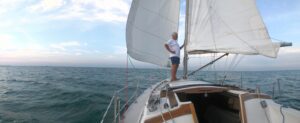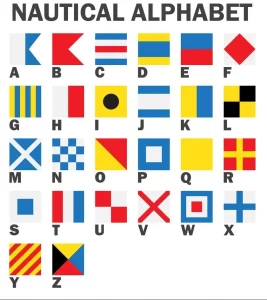Understanding the points of sail is fundamental to sailing. This refers to the boat’s orientation relative to the wind direction.
The Basics
- Tack: The side of the boat where the wind is coming from. A boat is either on a port tack (wind from the left) or a starboard tack (wind from the right).
- No-Go Zone: A sailboat cannot sail directly into the wind. This is known as the “no-go zone.” Trying to do so will cause the sails to flap and the boat to lose momentum.
- Close-Hauled: Sailing as close to the wind as possible. This is challenging and requires precise sail trim.
- Beam Reach: Sailing with the wind coming directly from the side of the boat. This is typically the fastest and easiest point of sail.
- Broad Reach: Sailing at a wide angle to the wind, with the wind coming from behind the boat.
- Running: Sailing directly downwind. Often involves using a spinnaker for maximum speed.
Sail Trimming
- Heading Up: Turning the boat towards the wind. Requires pulling in the sails (sheeting in).
- Bearing Away: Turning the boat away from the wind. Requires letting out the sails (easing the sheets).
Key to Sailing Success Continuously monitoring the wind direction is crucial. Paying attention to how the wind affects the boat will help you adjust your sails accordingly. Using yarn tied to the shrouds can be a helpful visual aid.
Understanding the Points of Sail
Sailboats harness the wind’s energy to move, and understanding how to position your boat relative to the wind is crucial for efficient sailing. This relationship is called the point of sail.
The No-Go Zone
Before we dive into the points of sail, let’s clarify a fundamental rule: A sailboat cannot sail directly into the wind. This is known as the no-go zone. Trying to do so will cause the sails to flap uselessly.
Points of Sail
Here’s a breakdown of the primary points of sail:
- Close-hauled: Sailing as close to the wind as possible. This is the most challenging point of sail, requiring precise sail trim.
- Close reach: Sailing at an angle slightly away from the wind. A good balance of speed and comfort.
- Beam reach: Sailing directly across the wind. Offers optimal speed and stability.
- Broad reach: Sailing with the wind coming from behind, at a wide angle.
- Running: Sailing directly downwind.
Visualizing the Points of Sail

points of sail diagram
Tacking and Jibing
To change direction, sailors use two maneuvers:
- Tacking: Turning the bow through the wind.
- Jibing: Turning the stern through the wind.
Mastering the Points of Sail
- Practice: The more you sail, the better your understanding will become.
- Sailing courses: Consider taking a sailing course for structured learning.
- Experiment: Try different points of sail in various wind conditions.
Choosing the Right Point of Sail
The best point of sail depends on factors like wind strength, your destination, and your boat’s capabilities. For example:
- Close-hauled is ideal for upwind sailing.
- Beam reach is often preferred for cruising due to its comfort.
- Broad reach and running offer speed but require more skill.
Remember: Safety is paramount. Always be aware of your surroundings and adjust your sails accordingly.
If you have any questions, please contact Captain Rene at (586) 770-2518




